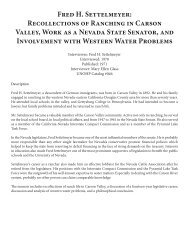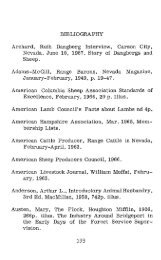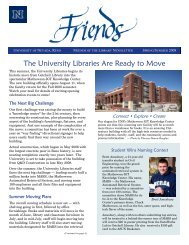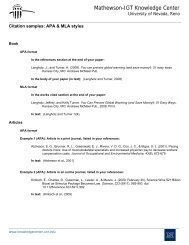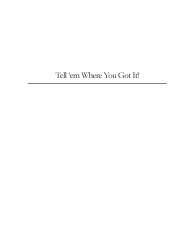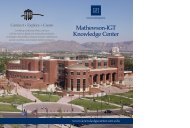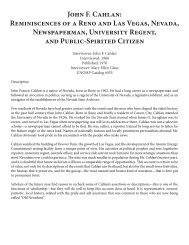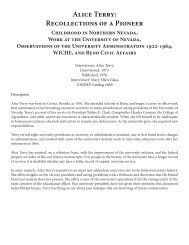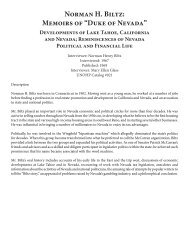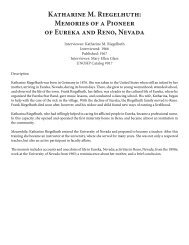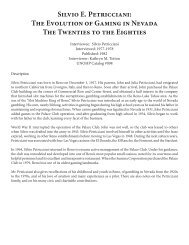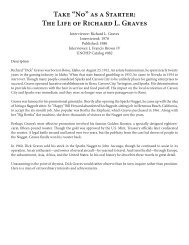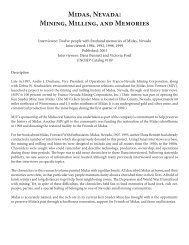An Interview with Jack Flanagan - University of Nevada, Reno
An Interview with Jack Flanagan - University of Nevada, Reno
An Interview with Jack Flanagan - University of Nevada, Reno
- No tags were found...
You also want an ePaper? Increase the reach of your titles
YUMPU automatically turns print PDFs into web optimized ePapers that Google loves.
Miner<br />
<strong>An</strong> <strong>Interview</strong> <strong>with</strong> <strong>Jack</strong> <strong>Flanagan</strong>:<br />
A Contribution to a Survey <strong>of</strong><br />
Life and Structures on the Comstock<br />
<strong>Interview</strong>er: <strong>An</strong>n Harvey<br />
Copyright 1984<br />
<strong>University</strong> <strong>of</strong> <strong>Nevada</strong> Oral History Program<br />
Mail Stop 0324<br />
<strong>Reno</strong>, <strong>Nevada</strong> 89557<br />
unohp@unr.edu<br />
http://www.unr.edu/oralhistory<br />
All rights reserved. Published 1984.<br />
Printed in the United States <strong>of</strong> America<br />
Publication Staff :<br />
Director: R.T. King<br />
<strong>University</strong> <strong>of</strong> <strong>Nevada</strong> Oral History Program Use Policy<br />
All UNOHP interviews are copyrighted materials. They may be downloaded and/or printed for<br />
personal reference and educational use, but not republished or sold. Under “fair use” standards,<br />
excerpts <strong>of</strong> up to 1000 words may be quoted for publication <strong>with</strong>out UNOHP permission as long<br />
as the use is non-commercial and materials are properly cited. The citation should include the<br />
title <strong>of</strong> the work, the name <strong>of</strong> the person or people interviewed, the date <strong>of</strong> publication or<br />
production, and the fact that the work was published or produced by the <strong>University</strong> <strong>of</strong> <strong>Nevada</strong><br />
Oral History Program (and collaborating institutions, when applicable). Requests for permission<br />
to quote for other publication, or to use any photos found <strong>with</strong>in the transcripts, should be<br />
addressed to the UNOHP, Mail Stop 0324, <strong>University</strong> <strong>of</strong> <strong>Nevada</strong>, <strong>Reno</strong>, <strong>Reno</strong>, NV 89557-0324.<br />
Original recordings <strong>of</strong> most UNOHP interviews are available for research purposes upon<br />
request.
On his Family’s migration west:<br />
When did your grandfather come to Virginia City<br />
Barney <strong>Flanagan</strong> came out here <strong>with</strong> his brother, Jim, on the completion <strong>of</strong> the V & T [Virginia &<br />
Truckee] Railroad, prior to 1880; they both worked on the V & T Railroad. The V & T was completed in<br />
1869, so it was about that time About that time. [My grandfather] was born in Louisville, Kentucky, and<br />
moved up to Cincinnati, Ohio, when he was 15 years old. In Ohio he worked on the B & O [Baltimore &<br />
Ohio] Railroad as a fireman. Then from Ohio he moved out to Virginia City at the request <strong>of</strong> his brother<br />
to become an engineer on the V & T Railroad. He was 18 years old at the time. (Page 1)<br />
On his father’s style <strong>of</strong> mining:<br />
You see, sometimes miners stayed a long time at one mine, and at other times they moved around. They<br />
would work here for a while; then they would take <strong>of</strong>f and go down to work in the mines in Tonopah.<br />
[When] they would get tired <strong>of</strong> that they would come back here and work the mines in Virginia City.<br />
[Then] they would get tired <strong>of</strong> that and go on up to Butte, Montana. Pretty soon you would see them<br />
back here in Virginia City again. They had a circuit that they worked back and forth between those 3<br />
towns. They gave them the name “tramp miners.” (Page 5)<br />
On his time as a miner:<br />
It was a routine job. You did the same thing day after day. If you were working in a stope the first thing<br />
you did when you went into the stope was remove the ore that the shift before had blasted. Then you<br />
would start in and put up your square-set timbers and make them real secure. Next you would get out<br />
your jackhammer or your stoper—whichever was needed at the time—and put in your round <strong>of</strong> holes,<br />
load the holes <strong>with</strong> powder, get out <strong>of</strong> the stope in a hurry and blast. [laughter] If you were a station<br />
tender your job all <strong>of</strong> the time was to load the cars on the cage. If you were a motorman you were the<br />
one on the surface who took the cars and hauled them by the motor out to the mill. It was a routine job.<br />
There was one advantage to working underground. No matter how cold it was on the surface you always<br />
knew when you went down there you would be working in a warm place. some parts <strong>of</strong> the mine were<br />
cool on account <strong>of</strong> their ventilation, but most <strong>of</strong> the mines were warm no matter what kind <strong>of</strong> a blizzard<br />
was on the surface.<br />
How much were the miners paid in the 1930s<br />
We were paid $4.50 a day. (Page 23)
<strong>Jack</strong> <strong>Flanagan</strong>



